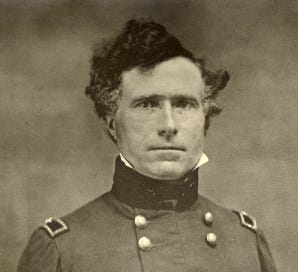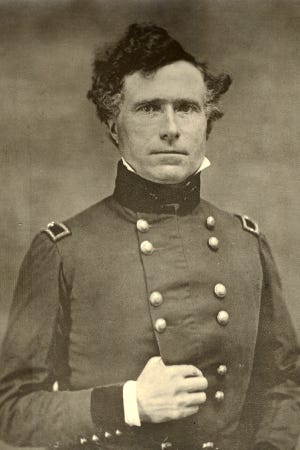Mystery Mondays: President Franklin Pierce, part 3
Seeking the origins of another presidential legend of Andover
This is the third and final segment of our three-part series on local legends surrounding President Franklin Pierce’s relationship with and time in Andover. If you missed the first two, click here to read part 1, the Summer Whitehouse, and here for part 2, the tragedy of the Pierce family.
In part 1, I dug into the origins of the story about the house at 48 Central Street serving as President Pierce’s “Summer White house” during his single term in office, 1853-1857. A strong lead on the origin came from our own files. In the History Center’s file was this hand-written note, found on a sheaf of anonymous notes.
But, search as I might, I could find no evidence of President Pierce visiting New England, let alone Andover, until October 1856. On a tour through New England states, the Andover Advertiser noted that,
This is his first visit to New England since his inauguration, and is said to be made solely for the purpose of attending to his private affairs.
In this third article, I’m going to dive into the second sentence of the note, “The Ripley house opposite was also used for offices (so said M. Newman).” Check out part 1 to learn more about M. Newman.
“M. Newman” was the Reverend Mark Newman who owned the house between 1818 and 1848. During the Pierce presidency, 1853-1857, the home was owned by Samuel Lawrence, an agent of the Bay State Woolen Company.
This note about the Ripley House, of course, sent me down on research rabbit hole on who in President Pierce’s administration would have used the Ripley house for offices. If indeed, Pierce had been in Andover during his time in office.
Origins of the modern American Presidency
Down the research rabbit hole I went to find out if 19th century presidents traveled with an entourage of cabinet members, staff, and assistants, as modern American presidents do. The answer, I found, was no.1
Historians often describe the mid-19th century presidents as “caretaker presidents,”
Martin Van Buren, William Henry Harrison, John Tyler, James K. Polk, Zachary Taylor, Franklin Pierce, James Buchanan, Rutherford B. Hayes, James Garfield, Chester Arthur, Grover Cleveland, and Millard Fillmore
Power in the 19th century resided in Congress, where important issues of the day were debated. It’s said that legislators of that era were more popular and well-known that presidents.
These presidents, some argue, mostly appointed federal workers and cabinet members. The Legislature set policy and made decisions. The modern president as the dominant force in government and politics emerged in the 20th century.
What about the Vice President? Did 19th century presidents travel with their vice president?
Definitely not in the case of President Pierce. Pierce’s Vice President William R. King died before he could be sworn into office. No Vice President was appointed to take his place.
One person, however, consistently mentioned as traveling with President Pierce: his private secretary Sidney Webster.
President Pierce’s private secretary
American presidents through Franklin Pierce recruited and paid their own private secretaries. Pierce’s successor James Buchanan was the first to have an official “Private Secretary at the White House” paid by the federal government. It wasn’t until 1900 that White House staff included a secretary to the President, assistant secretaries, clerks, stenographers, and more.2
President Pierce’s private secretary was fellow Concord, NH, resident Sidney Webster, nephew of famous legislator Daniel Webster.
Sidney Webster appeared in the Boston Evening Transcript on January 15, 1853. It was a short note received by telegraph from New York,
Among the arrivals at the Astor House yesterday were Horace Mann, Fitzhenry Warren, Sidney Webster, General Pierce’s Private Secretary from Concord, and General Wool…
Throughout February 1853, leading up to the March inauguration, Sidney Webster is reported to be traveling with the President Elect.
February 15, 1853 Boston Evening Transcript,
The President Elect. General Pierce left Concord yesterday afternoon, en route to Washington, accompanied only by his private Secretary, Sydney (sic) Webster, Esq…..The new Cabinet has been definitely been formed….As yet, Gen. P., and his private Secretary, and the members themselves, are the only persons who know how the Cabinet is constructed…
The article went on to report on arrangements that were being made to meet the President Elect in Baltimore to escort him to Washington.
General Pierce is with his wife, at the house of a relative. His private Secretary Sidney Webster, Esq., is at the Winthrop House (Boston). Today our city authorities and a number of citizens called on the President elect at the Tremont House in an informal manner.
Conjecture on the origin of the legend
Having been elected in November 1852, Pierce was preparing for his term in office and assembling his cabinet. It’s possible that his private secretary Sidney Webster traveled with him as plans were made.
If you read part 2 of this series, you might recall that Franklin and Jane Pierce’s son Benny died in a tragic train accident in Andover on January 6, 1853.
It could be that Sidney Webster was in Andover for Benny Pierce’s funeral on January 10th. If Webster was in Andover, it’s possible that he might have stayed at 47 Central Street across the street from the Aiken home at 48 Central Street.
That’s a lot of ifs!
It’s one possibility for how the Ripley House at 47 Central Street came to be described by Mark Newman as “being used for offices.”
With that, I’ll take my leave of this Mystery Monday’s legend. We can be reasonably sure that 48 Central Street was not President Pierce’s “Summer White house” because Pierce was not in New England or Andover during his presidency. But we can only conjecture about the Mark Newman note that the house at 47 Central Street served as his offices.
Thanks for reading!
~Elaine
Your likes, shares, comments, and subscriptions helps the Substack algorithm.
Did you know that you can give Gift Subscriptions to History Buzz? Click below to give the gift of History Buzz!
Resources
Michael F. Holt, Franklin Pierce: The American Presidents Series: The 14th President, 1853-1857
Sidney Webster, Franklin Pierce and His Administration, https://play.google.com/books/reader?id=WnBj_2fcfcsC&pg=GBS.PA16&hl=en
https://millercenter.org/the-presidency/teacher-resources/recasting-presidential-history/origins-modern-american-presidency








Thank you for all your emails asking me to correct the first version of this post. What is it about Franklin and Benjamin, and Benjamin and Franklin that makes me mix them up? Thanks again for letting me know! ~Elaine